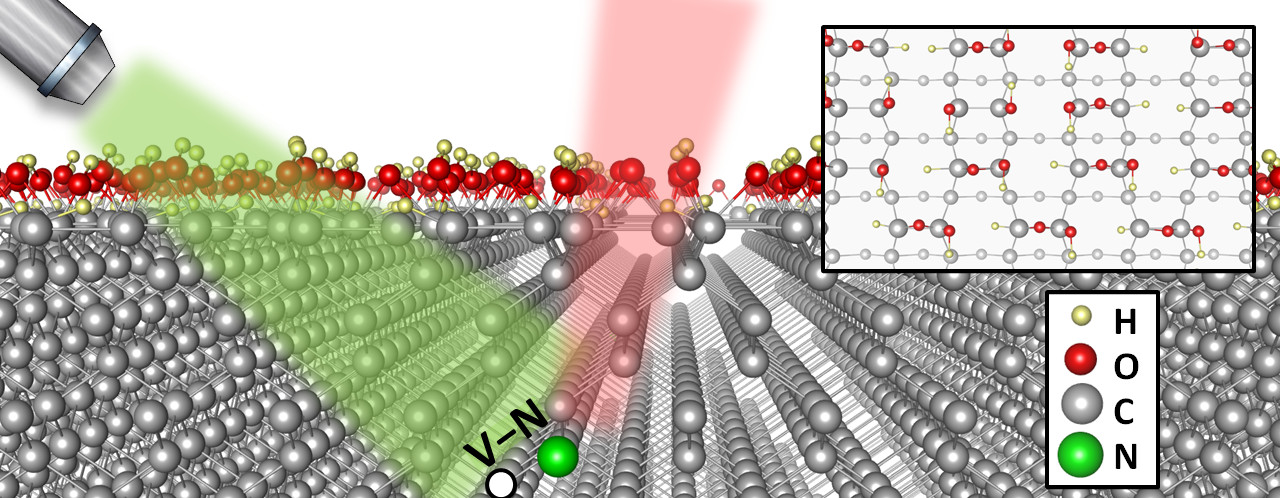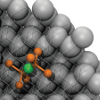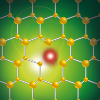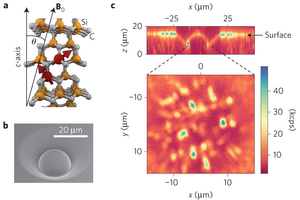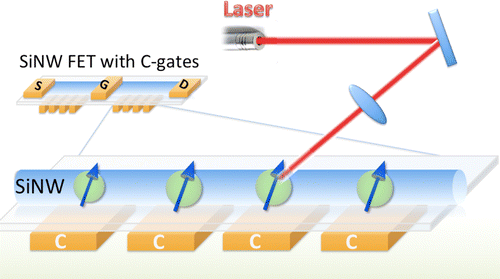Defects for quantum information processing
The idea of utilizing quantum systems to perform complicated quantum mechanical simulations and calculations was raised by Richard Feynman in 1982. This basic idea has initiated new directions in many disciplines and influenced different fields of nowadays physics. By now it has been widely accepted that quantum computation and information processing applications may possess extraordinary features and of great importance for future technologies.
Research groups at the very frontiers of physics are actively working on explaining the behavior and creating viable designs of the building blocks, such as quantum bits (qubits), quantum gates, etc. of would-be quantum computers. One of the most promising candidates for the realization of a qubit is the spin of a single point defect in semiconductors and insulators which can be considered as a good compromise compared to the solution of other contenders and has great technical advantages because of the large amount of accumulated experiences with materials processing. The extraordinary properties of defects such as the famous NV center in diamond allow optical control of the electron and nuclear spins. With applying static and radio and microwave electromagnetic fields to them, several quantum operations have been carried out by these systems so far.
Furthermore, thanks to the achieved ultimate control of electron spins, these point defects often can be utilized as nanoscale sensing tools. High sensitivity of their finely-tuned properties to environmental perturbations is the key feature behind this idea. This recent field of research and application is often called as nanometrology.
Our group actively contributes to the development of these new fields by first-principles and analytical characterization of well-established point defects and promising candidates thereof.
Nitrogen-vacancy center in diamond
The nitrogen-vacancy (NV) center in diamond is a leading contender for realizing the solid state spin qubits concept in quantum information. Our group significantly contributed to the understanding of optical and magnetic properties of this defect, and is continuously investigating those as a function of external perturbations, temperature, surface effects or quantum confinement.
We successfully determined the hyperfine tensors of the nuclei with non-zero nuclei spins and identified the qubits realized by proximate 13C isotopes [PhysRevB.77.155206]Author: Gali, Adam; Fyta, Maria; Kaxiras, Efthimios
Journal: Phys. Rev. B
Month: Apr
Pages: 155206
Title: \textit{Ab initio} supercell calculations on nitrogen-vacancy center in diamond: Electronic structure and hyperfine tensors
Url: http://link.aps.org/doi/10.1103/PhysRevB.77.155206
Volume: 77
Year: 2008 . We calculated the corresponding hyperfine tensors in the electronic excited states too and analyzed their role in the so-called excited state level anti-crossing mechanism leading to the nuclear spin polarization in NV center [PhysRevB.80.241204]Author: Gali, Adam
. We calculated the corresponding hyperfine tensors in the electronic excited states too and analyzed their role in the so-called excited state level anti-crossing mechanism leading to the nuclear spin polarization in NV center [PhysRevB.80.241204]Author: Gali, Adam
Journal: Phys. Rev. B
Month: Dec
Pages: 241204
Title: Identification of individual $^{13}\text{C}$ isotopes of nitrogen-vacancy center in diamond by combining the polarization studies of nuclear spins and first-principles calculations
Url: http://link.aps.org/doi/10.1103/PhysRevB.80.241204
Volume: 80
Year: 2009 . After then the nature of the hyperfine interaction of these nuclei was analyzed in detail [PhysRevB.88.075202]Author: Sz\'asz, Kriszti\'an; Hornos, Tam\'as; Marsman, Martijn; Gali, Adam
. After then the nature of the hyperfine interaction of these nuclei was analyzed in detail [PhysRevB.88.075202]Author: Sz\'asz, Kriszti\'an; Hornos, Tam\'as; Marsman, Martijn; Gali, Adam
Journal: Phys. Rev. B
Pages: 075202
Title: Hyperfine coupling of point defects in semiconductors by hybrid density functional calculations: The role of core spin polarization
Url: http://link.aps.org/doi/10.1103/PhysRevB.88.075202
Volume: 88
Year: 2013 .
.
We analyzed the electronic structure and the hyperfine signals of the neutral NV defect in detail [PhysRevB.79.235210]Author: Gali, Adam
Journal: Phys. Rev. B
Month: Jun
Pages: 235210
Title: Theory of the neutral nitrogen-vacancy center in diamond and its application to the realization of a qubit
Url: http://link.aps.org/doi/10.1103/PhysRevB.79.235210
Volume: 79
Year: 2009 and proposed a scheme to utilize it for quantum information processing. Later on we proposed a model on the dynamical charge switching between the neutral NV defect and the negatively charged NV defect upon strong laser illumination based on quantum mechanical calculations. To this end, we calculated the radiative lifetimes and non-radiative Auger-rates of NV center [PhysRevLett.106.157601]Author: Waldherr, G.; Beck, J.; Steiner, M.; Neumann, P.; Gali, A.; Frauenheim, Th.; Jelezko, F.; Wrachtrup, J.
and proposed a scheme to utilize it for quantum information processing. Later on we proposed a model on the dynamical charge switching between the neutral NV defect and the negatively charged NV defect upon strong laser illumination based on quantum mechanical calculations. To this end, we calculated the radiative lifetimes and non-radiative Auger-rates of NV center [PhysRevLett.106.157601]Author: Waldherr, G.; Beck, J.; Steiner, M.; Neumann, P.; Gali, A.; Frauenheim, Th.; Jelezko, F.; Wrachtrup, J.
Journal: Phys. Rev. Lett.
Month: Apr
Pages: 157601
Title: Dark States of Single Nitrogen-Vacancy Centers in Diamond Unraveled by Single Shot NMR
Url: http://link.aps.org/doi/10.1103/PhysRevLett.106.157601
Volume: 106
Year: 2011 , [PhysRevLett.110.167402]Author: Siyushev, P.; Pinto, H.; V\"or\"os, M.; Gali, A.; Jelezko, F.; Wrachtrup, J.
, [PhysRevLett.110.167402]Author: Siyushev, P.; Pinto, H.; V\"or\"os, M.; Gali, A.; Jelezko, F.; Wrachtrup, J.
Journal: Phys. Rev. Lett.
Pages: 167402
Title: Optically Controlled Switching of the Charge State of a Single Nitrogen-Vacancy Center in Diamond at Cryogenic Temperatures
Url: http://link.aps.org/doi/10.1103/PhysRevLett.110.167402
Volume: 110
Year: 2013 .
.
The Stokes-shift in the photo-excitation of the NV center was accurately determined [gali2009]Author: Gali, Ádám; Erik, Janzén; Deák, Péter; Georg, Kresse; Efthimios, Kaxiras
Journal: Physical Review Letters
Month: oct
Number: 18
Pages: 186404
Title: Theory of Spin-Conserving Excitation of the N-V- Center in Diamond
Url: http://link.aps.org/doi/10.1103/PhysRevLett.103.186404
Volume: 103
Year: 2009 . The position and the nature of the singlet shelving states are still in active investigation by experimental and theoretical methods where we contributed to this field by group theory analysis [MazeGali2011]Author: J R Maze; A Gali; E Togan; Y Chu; A Trifonov; E Kaxiras; M D Lukin
. The position and the nature of the singlet shelving states are still in active investigation by experimental and theoretical methods where we contributed to this field by group theory analysis [MazeGali2011]Author: J R Maze; A Gali; E Togan; Y Chu; A Trifonov; E Kaxiras; M D Lukin
Journal: New Journal of Physics
Number: 2
Pages: 025025
Title: Properties of nitrogen-vacancy centers in diamond: the group theoretic approach
Url: http://stacks.iop.org/1367-2630/13/i=2/a=025025
Volume: 13
Year: 2011 and calculating the excited states by a parameter-free many-body theory called GW+BSE [PhysRevB.81.041204]Author: Ma, Yuchen; Rohlfing, Michael; Gali, Adam
and calculating the excited states by a parameter-free many-body theory called GW+BSE [PhysRevB.81.041204]Author: Ma, Yuchen; Rohlfing, Michael; Gali, Adam
Journal: Phys. Rev. B
Month: Jan
Pages: 041204
Title: Excited states of the negatively charged nitrogen-vacancy color center in diamond
Url: http://link.aps.org/doi/10.1103/PhysRevB.81.041204
Volume: 81
Year: 2010 . We also calculated the adiabatic charge transition levels of NV defect that can be important in understanding the photo-ionization of NV center [Deak2014]Author: De\'ak, Peter; Aradi, B\'alint; Kaviani, Moloud; Frauenheim, Thomas; Gali, Adam
. We also calculated the adiabatic charge transition levels of NV defect that can be important in understanding the photo-ionization of NV center [Deak2014]Author: De\'ak, Peter; Aradi, B\'alint; Kaviani, Moloud; Frauenheim, Thomas; Gali, Adam
Journal: Phys. Rev. B
Pages: 075203
Title: Formation of NV centers in diamond: A theoretical study based on calculated transitions and migration of nitrogen and vacancy related defects
Url: http://link.aps.org/doi/10.1103/PhysRevB.89.075203
Volume: 89
Year: 2014 . In addition, by calculating the formation energies of vacancy, nitrogen and related defects we concluded that vacancies created by implantation or other related techniques are contributing the most to the formation of NV centers, and the long-range diffusion of vacancies may not play a key role [Deak2014]Author: De\'ak, Peter; Aradi, B\'alint; Kaviani, Moloud; Frauenheim, Thomas; Gali, Adam
. In addition, by calculating the formation energies of vacancy, nitrogen and related defects we concluded that vacancies created by implantation or other related techniques are contributing the most to the formation of NV centers, and the long-range diffusion of vacancies may not play a key role [Deak2014]Author: De\'ak, Peter; Aradi, B\'alint; Kaviani, Moloud; Frauenheim, Thomas; Gali, Adam
Journal: Phys. Rev. B
Pages: 075203
Title: Formation of NV centers in diamond: A theoretical study based on calculated transitions and migration of nitrogen and vacancy related defects
Url: http://link.aps.org/doi/10.1103/PhysRevB.89.075203
Volume: 89
Year: 2014 . In addition, we found that divacancy may form in the process of NV formation that can pin the Fermi-level so the charge state of NV defects [Deak2014]Author: De\'ak, Peter; Aradi, B\'alint; Kaviani, Moloud; Frauenheim, Thomas; Gali, Adam
. In addition, we found that divacancy may form in the process of NV formation that can pin the Fermi-level so the charge state of NV defects [Deak2014]Author: De\'ak, Peter; Aradi, B\'alint; Kaviani, Moloud; Frauenheim, Thomas; Gali, Adam
Journal: Phys. Rev. B
Pages: 075203
Title: Formation of NV centers in diamond: A theoretical study based on calculated transitions and migration of nitrogen and vacancy related defects
Url: http://link.aps.org/doi/10.1103/PhysRevB.89.075203
Volume: 89
Year: 2014 .
.
Recently, we have started to study the effect of different perturbations on the critical defect's properties.
As the quantum-optics protocols of the nitrogen-vacancy (NV) center rely on its negative charge state in diamond, the control of the charge state of the NV center is a prerequisite to apply them in sensor applications where NV centers should be placed as close as possible to the surface of diamond for efficient sensing of the targeted nano-objects. Advanced technologies have made possible to implant NV centers <1 nm in depth from the surface [Okai2012]Author: Ofori-Okai, B.K.; Pezzagna, S.; Chang, K.; Loretz, M.; Schirhagl, R.; Tao, Y.; Moores, B.A.; Groot-Berning, K.; Meijer, J.; Degen, C.L.
Journal: Physical Review B
Pages: 081406
Title: Spin properties of very shallow nitrogen vacancy defects in diamond
Url: http://journals.aps.org/prb/abstract/10.1103/PhysRevB.86.081406
Volume: 86
Year: 2012 in a controlled fashion, and luminescent ultrasmall ∼5 nm nanodiamonds could be also fabricated [Bradac2010]Author: Bradac, C.; Gaebel, T.; Naidoo, N.; Sellars, M.J.; Twamley, J.; Brown, L.J.; Barnard, A.S.; Plakhotnik, T.; Zvyagin, A.V.; Rabeau, J.R.
in a controlled fashion, and luminescent ultrasmall ∼5 nm nanodiamonds could be also fabricated [Bradac2010]Author: Bradac, C.; Gaebel, T.; Naidoo, N.; Sellars, M.J.; Twamley, J.; Brown, L.J.; Barnard, A.S.; Plakhotnik, T.; Zvyagin, A.V.; Rabeau, J.R.
Journal: Nature Nanotechnology
Pages: 345-349
Title: Observation and control of blinking nitrogen-vacancy centres in discrete nanodiamonds
Url: http://www.nature.com/nnano/journal/v5/n5/abs/nnano.2010.56.html
Volume: 5
Year: 2010 where NV centers are naturally located very close to the nanodiamond surface. In this work, we showed by accurate quantum mechanical simulations that typical diamond surfaces possess image states with sub-bandgap energies which compromise the photo-stability of the NV centers placed within a few nm of the surface. This occurs due to the mixture of the NV-related gap states and the surface image states which is a novel and distinct process from the well established band bending effect. We find that certain types of hydrogen, oxygen and fluorine coverages of diamond surface may lead to blinking or bleaching due to the presence of acceptor surface states. We identify a combination of surface terminators that is perfect for NV-center based nanoscale sensing and this work has been published in Nano Letters [Moloud2014]Author: Kaviani, Moloud; Deák, Peter; Aradi, Bálint; Frauenheim, Thomas; Chou, Jyh-Pin; Gali, Adam
where NV centers are naturally located very close to the nanodiamond surface. In this work, we showed by accurate quantum mechanical simulations that typical diamond surfaces possess image states with sub-bandgap energies which compromise the photo-stability of the NV centers placed within a few nm of the surface. This occurs due to the mixture of the NV-related gap states and the surface image states which is a novel and distinct process from the well established band bending effect. We find that certain types of hydrogen, oxygen and fluorine coverages of diamond surface may lead to blinking or bleaching due to the presence of acceptor surface states. We identify a combination of surface terminators that is perfect for NV-center based nanoscale sensing and this work has been published in Nano Letters [Moloud2014]Author: Kaviani, Moloud; Deák, Peter; Aradi, Bálint; Frauenheim, Thomas; Chou, Jyh-Pin; Gali, Adam
Journal: Nano Letters
Month: july
Number: 8
Pages: 4772-4777
Title: Proper Surface Termination for Luminescent Near-Surface NV centers in Diamomnd
Url: http://pubs.acs.org/doi/full/10.1021/nl501927y
Volume: 14
Year: 2014 .
.
We applied an ab initio theory of the zero-field splitting (ZFS) of the NV center as a function of external pressure and temperature including detailed analysis on the contributions of macroscopic and microscopic effects. We found that the pressure dependence is governed by the change in the distance between spins as a consequence of the global compression and the additional local structural relaxation. The local structural relaxation contributes to the change of ZFS with the same magnitude as the global compression. In the case of temperature dependence of ZFS, we investigated the effect of macroscopic thermal expansion as well as the consequent change of the microscopic equilibrium positions. We could conclude that theses effects are responsible for about 15% of the observed decrease of ZFS [PhysRevB.90.235205]Author: Iv\'ady, Viktor; Simon, Tam\'as; Maze, Jeronimo R.; Abrikosov, I. A.; Gali, Adam
Journal: Phys. Rev. B
Month: Dec
Pages: 235205
Title: Pressure and temperature dependence of the zero-field splitting in the ground state of NV centers in diamond: A first-principles study
Url: http://link.aps.org/doi/10.1103/PhysRevB.90.235205
Volume: 90
Year: 2014 .
.
Silicon-vacancy center in diamond
In a cooperation with partners in Russia and Germany, we have taken part in the work [Vlasov2014]Author: Igor I. Vlasov; Andrey A. Shiryaev; Torsten Rendler; Steffen Steinert; Sang-Yun Lee; Denis Antonov; M\'arton V\"or\"os; Fedor Jelezko; Anatolii V. Fisenko; Lubov F. Semjonova; Johannes Biskupek; Ute Kaiser; Oleg I. Lebedev; Ilmo Sildos; Philip. R. Hemmer; Vitaly I. Konov; Adam Gali ; J\"org Wrachtrup
Journal: Nature Nanotechn.
Pages: 54-58
Title: Molecular-sized fluorescent nanodiamonds
Url: http://www.nature.com/nnano/journal/v9/n1/full/nnano.2013.255.html
Volume: 9
Year: 2014 of predicting and validating the properties of silicon-vacancy colour centres in nanosized diamond particles. We have contributed with time-dependent DFT calculations, not carried out on such large systems so far. Nanoparticles for validating experiments have been extracted from a meteorite sample, but production of similar artificial nanoparticles seems to be very prospective in e.g. biosensing. This article has been selected for review[becher2014fluorescent]Author: Becher, Christoph
of predicting and validating the properties of silicon-vacancy colour centres in nanosized diamond particles. We have contributed with time-dependent DFT calculations, not carried out on such large systems so far. Nanoparticles for validating experiments have been extracted from a meteorite sample, but production of similar artificial nanoparticles seems to be very prospective in e.g. biosensing. This article has been selected for review[becher2014fluorescent]Author: Becher, Christoph
Journal: Nature nanotechnology
Number: 1
Pages: 16--17
Title: Fluorescent nanoparticles: Diamonds from outer space
Volume: 9
Year: 2014 in Nature News and Views.
in Nature News and Views.
Silicon carbide defects
The extraordinary properties of NV-center in diamond exhibit great potential for the investigation of point defect based quantum information processing systems. However, from the application point of view the extreme hardness of diamond may cause difficulties in fabrication and can hinder the spreading of possible applications. Among the first, our group proposed the idea of considering silicon carbide (SiC) as a new target of research, which is a device friendly material but may host promising defects for quantum information processing. The idea of using SiC to host solid state quantum bits supported by the combination of quantum mechanical calculations and group theory analysis was first openly suggested by Adam Gali at International Conference of SiC and Related Materials 2009 (Nürnberg, Germany, 2009) [Gali10]Author: Gali, A.; G\"allstr\"om, A.; Son, N.T.; Janz\'en, E.
Journal: Mater. Sci. Forum
Pages: 395-397
Title: Theory of Neutral Divacancy in SiC: A Defect for Spintronics
Volume: 645-648
Year: 2010 where divacancy was the primary candidate [Gali10]Author: Gali, A.; G\"allstr\"om, A.; Son, N.T.; Janz\'en, E.
where divacancy was the primary candidate [Gali10]Author: Gali, A.; G\"allstr\"om, A.; Son, N.T.; Janz\'en, E.
Journal: Mater. Sci. Forum
Pages: 395-397
Title: Theory of Neutral Divacancy in SiC: A Defect for Spintronics
Volume: 645-648
Year: 2010 , [Gali2011-TDDFT]Author: Gali, Adam
, [Gali2011-TDDFT]Author: Gali, Adam
Journal: physica status solidi (b)
Number: 6
Pages: 1337--1346
Title: Time-dependent density functional study on the excitation spectrum of point defects in semiconductors
Url: http://dx.doi.org/10.1002/pssb.201046254
Volume: 248
Year: 2011 . Later other candidates were also theoretically studied [Weber2010]Author: Weber, J. R.; Koehl, W. F.; Varley, J. B.; Janotti, A.; Buckley, B. B.; Van de Walle, C. G.; Awschalom, D. D.
. Later other candidates were also theoretically studied [Weber2010]Author: Weber, J. R.; Koehl, W. F.; Varley, J. B.; Janotti, A.; Buckley, B. B.; Van de Walle, C. G.; Awschalom, D. D.
Journal: Proceedings of the National Academy of Sciences
Number: 19
Pages: 8513-8518
Title: Quantum computing with defects
Url: http://www.pnas.org/content/107/19/8513.abstract
Volume: 107
Year: 2010 . The first breakthrough has been achieved for the coherent manipulation of ensemble divacancy and related defect spins in 4H polytype of SiC by the Awschalom group [Koehl2011]Author: Koehl, William F.; Buckley, Bob B.; Heremans, F. J.; Calusine, Greg; Awschalom, David D.
. The first breakthrough has been achieved for the coherent manipulation of ensemble divacancy and related defect spins in 4H polytype of SiC by the Awschalom group [Koehl2011]Author: Koehl, William F.; Buckley, Bob B.; Heremans, F. J.; Calusine, Greg; Awschalom, David D.
Journal: Nature
Pages: 84-87
Title: Room temperature coherent control of defect spin qubits in silicon carbide
Volume: 479
Year: 2011 .
.
Investigation of new candidates in SiC is a rapidly developing direction of nowadays research. In this respect, the most actively studied defects in SiC are the divacancy, the silicon vacancy, and the carbon antisite-vacancy pair.
Divacancy
The electron spins of semiconductor defects can have complex interactions with their host, particularly in polar materials like SiC where electrical and mechanical variables are intertwined. By combining pulsed spin resonance (David Awschalom group at Chicago University) with ab initio simulations, we show that spin-spin interactions in 4H−SiC neutral divacancies give rise to spin states with a strong Stark effect, sub-10−6 strain sensitivity, and highly spin-dependent photoluminescence with intensity contrasts of 15%–36%. These results establish SiC color centers as compelling systems for sensing nanoscale electric and strain fields.
Physical Review Letters 112 187601 (2014). DOI:10.1103/PhysRevLett.112.187601
Carbon antisite-vacancy pair defects
In an international cooperation with Japanese and Australian colleagues, we supported the establishment and identification[castelletto2014silicon]Author: Castelletto, S; Johnson, BC; Iv{\'a}dy, Viktor; Stavrias, N; Umeda, T; Gali, A; Ohshima, T
Journal: Nature materials
Number: 2
Pages: 151--156
Title: A silicon carbide room-temperature single-photon source
Volume: 13
Year: 2014 of the carbon antisite–vacancy pair as a world-record bright single-photon emitter in silicon carbide with theoretical work and computational simulation. The results have been highlighted in Nature Physics[aharonovich2014optical]Author: Aharonovich, Igor; Toth, Milos
of the carbon antisite–vacancy pair as a world-record bright single-photon emitter in silicon carbide with theoretical work and computational simulation. The results have been highlighted in Nature Physics[aharonovich2014optical]Author: Aharonovich, Igor; Toth, Milos
Journal: Nature Physics
Number: 2
Pages: 93--94
Title: Optical materials : Silicon carbide goes quantum
Volume: 10
Year: 2014 and Nature Photonics[boretti2014optical]Author: Boretti, Alberto
and Nature Photonics[boretti2014optical]Author: Boretti, Alberto
Journal: Nature Photonics
Number: 2
Pages: 88--90
Title: Optical materials: Silicon carbide's quantum aspects
Volume: 8
Year: 2014 .
Nature Materials 13 151-156 (2014) DOI:10.1038/nmat3806
.
Nature Materials 13 151-156 (2014) DOI:10.1038/nmat3806
Our group members at Wigner ADMIL laboratory have succeeded manufacturing carbon antisite–vacancy colour centres in silcon carbide nanoparticles. In collaboration with Australian researchers we showed that these colour centres behave as single-photon emitters, and therefore may be used in the future in nanometrology and quantum informatics. The biocompatibiliy of SiC makes these defects ideal candidates for biosensing at the molecular level. According to our single advanced density functional theory calculations the photoluminescence can be associated with the double positive charge state of the carbon antisite-vacancy pair in 3C-SiC, in contrast to the previous assignment (Si-vacancy) [castelletto2014room]Author: Castelletto, Stefania; Johnson, Brett C.; Zachreson, Cameron; Beke, David; Balogh, István; Ohshima, Takeshi; Aharonovich, Igor; Gali, Adam
Journal: ACS Nano
Note: PMID: 25036593
Number: 8
Pages: 7938-7947
Title: Room Temperature Quantum Emission from Cubic Silicon Carbide Nanoparticles
Url: http://dx.doi.org/10.1021/nn502719y
Volume: 8
Year: 2014 .
.
ACS Nano 8 7938-7947 (2014). DOI:10.1021/nn502719y
Silicon-vacancy
Adam Gali has been shown by ab initio calculations that the negatively charged silicon vacancy (Si-vacancy) can be associated with the Tv2a and related photoluminescence centers with possessing S=3/2 spin [Gali2012-MSF]Author: Gali, A.
Journal: Mater. Sci. Forum
Pages: 255-258
Title: Excitation Properties of Silicon Vacancy in Silicon Carbide
Volume: 717-720
Year: 2012 . It has been analyzed by the combination of quantum mechanical calculations and group theory how this defect can be utilized to realize qubits [Gali2012-TDDFT]Author: Gali, A.
. It has been analyzed by the combination of quantum mechanical calculations and group theory how this defect can be utilized to realize qubits [Gali2012-TDDFT]Author: Gali, A.
Journal: J. Mater. Res.
Pages: 897-909
Title: Excitation spectrum of point defects in semiconductors studied by time-dependent density functional theory
Volume: 27
Year: 2012 .
.
In collaboration with German (Jörg Wrachtrup group at Stuttgart University) and Swedish (Erik Janzén group at Linköping University) researchers, we report the characterization of photoluminescence and optical spin polarization from single silicon vacancies in SiC, and demonstrate that single spins can be addressed at room temperature. We show coherent control of a single defect spin and find long spin coherence times under ambient conditions. Our study provides evidence that SiC is a promising system for atomic-scale spintronics and quantum technology. Our study is highlighted in a News and Views article from Nature Materials.
Nature Materials 15 164-168 (2015). DOI:10.1038/nmat4145
P-donor in ultrathin Si nanowires
A phosphorus (P) donor has been extensively studied in bulk Si to realize the concept of Kane quantum computers. In most cases the quantum bit was realized as an entanglement between the donor electron spin and the nonzero nuclei spin of the donor impurity mediated by the hyperfine coupling between them. The donor ionization energies and the spin–lattice relaxation time limited the temperatures to a few kelvin in these experiments. We demonstrated by means of ab initio density functional theory calculations that quantum confinement in thin Si nanowires (SiNWs) results in (i) larger excitation energies of donor impurity and (ii) a sensitive manipulation of the hyperfine coupling by external electric field. We proposed that these features may allow to realize the quantum bit (qubit) experiments at elevated temperatures with a strength of electric fields applicable in current field-effect transistor technology. We also showed that the strength of quantum confinement and the presence of strain induced by the surface termination may significantly affect the ground and excited states of the donors in thin SiNWs, possibly allowing an optical read-out of the electron spin [doi:10.1021/nl300816t]Author: Yan, Binghai; Rurali, Riccardo; Gali, \'Ad\'am
Journal: Nano Letters
Note: PMID: 22694292
Number: 7
Pages: 3460-3465
Title: Ab Initio Study of Phosphorus Donors Acting as Quantum Bits in Silicon Nanowires
Url: http://dx.doi.org/10.1021/nl300816t
Volume: 12
Year: 2012 .
.
Nano Letters 12 3460-3465 (2012). DOI:10.1021/nl300816t
Bibliography
| [Bradac2010] | Bradac, C.; Gaebel, T.; Naidoo, N.; Sellars, M.J.; Twamley, J.; Brown, L.J.; Barnard, A.S.; Plakhotnik, T.; Zvyagin, A.V.; Rabeau, J.R. (2010): Observation and control of blinking nitrogen-vacancy centres in discrete nanodiamonds. Nature Nanotechnology, 5, 345-349 |  |
| [Deak2014] | De\'ak, Peter; Aradi, B\'alint; Kaviani, Moloud; Frauenheim, Thomas; Gali, Adam (2014): Formation of NV centers in diamond: A theoretical study based on calculated transitions and migration of nitrogen and vacancy related defects. Phys. Rev. B, 89, 075203 |  |
| [Gali10] | Gali, A.; G\"allstr\"om, A.; Son, N.T.; Janz\'en, E. (2010): Theory of Neutral Divacancy in SiC: A Defect for Spintronics. Mater. Sci. Forum, 645-648, 395-397 |  |
| [Gali2011-TDDFT] | Gali, Adam (2011): Time-dependent density functional study on the excitation spectrum of point defects in semiconductors. physica status solidi (b), 248, 1337--1346 |  |
| [Gali2012-MSF] | Gali, A. (2012): Excitation Properties of Silicon Vacancy in Silicon Carbide. Mater. Sci. Forum, 717-720, 255-258 |  |
| [Gali2012-TDDFT] | Gali, A. (2012): Excitation spectrum of point defects in semiconductors studied by time-dependent density functional theory. J. Mater. Res., 27, 897-909 |  |
| [Koehl2011] | Koehl, William F.; Buckley, Bob B.; Heremans, F. J.; Calusine, Greg; Awschalom, David D. (2011): Room temperature coherent control of defect spin qubits in silicon carbide. Nature, 479, 84-87 |  |
| [MazeGali2011] | J R Maze; A Gali; E Togan; Y Chu; A Trifonov; E Kaxiras; M D Lukin (2011): Properties of nitrogen-vacancy centers in diamond: the group theoretic approach. New Journal of Physics, 13, 025025 |  |
| [Moloud2014] | Kaviani, Moloud; De\'{a}k, Peter; Aradi, B\'{a}lint; Frauenheim, Thomas; Chou, Jyh-Pin; Gali, Adam (2014): Proper Surface Termination for Luminescent Near-Surface NV centers in Diamomnd. Nano Letters, 14, 4772-4777 |  |
| [Okai2012] | Ofori-Okai, B.K.; Pezzagna, S.; Chang, K.; Loretz, M.; Schirhagl, R.; Tao, Y.; Moores, B.A.; Groot-Berning, K.; Meijer, J.; Degen, C.L. (2012): Spin properties of very shallow nitrogen vacancy defects in diamond. Physical Review B, 86, 081406 |  |
| [PhysRevB.77.155206] | Gali, Adam; Fyta, Maria; Kaxiras, Efthimios (2008): \textit{Ab initio} supercell calculations on nitrogen-vacancy center in diamond: Electronic structure and hyperfine tensors. Phys. Rev. B, 77, 155206 |  |
| [PhysRevB.79.235210] | Gali, Adam (2009): Theory of the neutral nitrogen-vacancy center in diamond and its application to the realization of a qubit. Phys. Rev. B, 79, 235210 |  |
| [PhysRevB.80.241204] | Gali, Adam (2009): Identification of individual $^{13}\text{C}$ isotopes of nitrogen-vacancy center in diamond by combining the polarization studies of nuclear spins and first-principles calculations. Phys. Rev. B, 80, 241204 |  |
| [PhysRevB.81.041204] | Ma, Yuchen; Rohlfing, Michael; Gali, Adam (2010): Excited states of the negatively charged nitrogen-vacancy color center in diamond. Phys. Rev. B, 81, 041204 |  |
| [PhysRevB.88.075202] | Sz\'asz, Kriszti\'an; Hornos, Tam\'as; Marsman, Martijn; Gali, Adam (2013): Hyperfine coupling of point defects in semiconductors by hybrid density functional calculations: The role of core spin polarization. Phys. Rev. B, 88, 075202 |  |
| [PhysRevB.90.235205] | Iv\'ady, Viktor; Simon, Tam\'as; Maze, Jeronimo R.; Abrikosov, I. A.; Gali, Adam (2014): Pressure and temperature dependence of the zero-field splitting in the ground state of NV centers in diamond: A first-principles study. Phys. Rev. B, 90, 235205 |  |
| [PhysRevLett.106.157601] | Waldherr, G.; Beck, J.; Steiner, M.; Neumann, P.; Gali, A.; Frauenheim, Th.; Jelezko, F.; Wrachtrup, J. (2011): Dark States of Single Nitrogen-Vacancy Centers in Diamond Unraveled by Single Shot NMR. Phys. Rev. Lett., 106, 157601 |  |
| [PhysRevLett.110.167402] | Siyushev, P.; Pinto, H.; V\"or\"os, M.; Gali, A.; Jelezko, F.; Wrachtrup, J. (2013): Optically Controlled Switching of the Charge State of a Single Nitrogen-Vacancy Center in Diamond at Cryogenic Temperatures. Phys. Rev. Lett., 110, 167402 |  |
| [Vlasov2014] | Igor I. Vlasov; Andrey A. Shiryaev; Torsten Rendler; Steffen Steinert; Sang-Yun Lee; Denis Antonov; M\'arton V\"or\"os; Fedor Jelezko; Anatolii V. Fisenko; Lubov F. Semjonova; Johannes Biskupek; Ute Kaiser; Oleg I. Lebedev; Ilmo Sildos; Philip. R. Hemmer; Vitaly I. Konov; Adam Gali ; J\"org Wrachtrup (2014): Molecular-sized fluorescent nanodiamonds. Nature Nanotechn., 9, 54-58 |  |
| [Weber2010] | Weber, J. R.; Koehl, W. F.; Varley, J. B.; Janotti, A.; Buckley, B. B.; Van de Walle, C. G.; Awschalom, D. D. (2010): Quantum computing with defects. Proceedings of the National Academy of Sciences, 107, 8513-8518 |  |
| [aharonovich2014optical] | Aharonovich, Igor; Toth, Milos (2014): Optical materials : Silicon carbide goes quantum. Nature Physics, 10, 93--94 |  |
| [becher2014fluorescent] | Becher, Christoph (2014): Fluorescent nanoparticles: Diamonds from outer space. Nature nanotechnology, 9, 16--17 |  |
| [boretti2014optical] | Boretti, Alberto (2014): Optical materials: Silicon carbide's quantum aspects. Nature Photonics, 8, 88--90 |  |
| [castelletto2014room] | Castelletto, Stefania; Johnson, Brett C.; Zachreson, Cameron; Beke, David; Balogh, István; Ohshima, Takeshi; Aharonovich, Igor; Gali, Adam (2014): Room Temperature Quantum Emission from Cubic Silicon Carbide Nanoparticles. ACS Nano, 8, 7938-7947 |  |
| [castelletto2014silicon] | Castelletto, S; Johnson, BC; Iv{\'a}dy, Viktor; Stavrias, N; Umeda, T; Gali, A; Ohshima, T (2014): A silicon carbide room-temperature single-photon source. Nature materials, 13, 151--156 |  |
| [doi:10.1021/nl300816t] | Yan, Binghai; Rurali, Riccardo; Gali, \'Ad\'am (2012): Ab Initio Study of Phosphorus Donors Acting as Quantum Bits in Silicon Nanowires. Nano Letters, 12, 3460-3465 |  |
| [Gali2009] | Gali, \'{A}d\'{a}m; Erik, Janz\'{e}n; De\'{a}k, P\'{e}ter; Georg, Kresse; Efthimios, Kaxiras (2009): Theory of Spin-Conserving Excitation of the N-V- Center in Diamond. Physical Review Letters, 103, 186404 |  |
